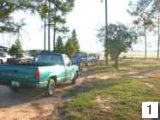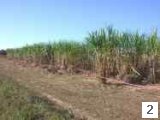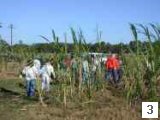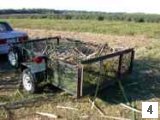|
The
University of Florida's
Institute of Food and
Agricultural Science,
Quincy
In my opinion, it is not idle
hyperbole to claim that, in large measure, our historical
prosperity results from a large arable land mass, enough
water if we use it wisely, a low population density until
now, and the research and extension arms of the land-grant
universities. One activity of this system is to provide
limited propagation materials of superior cultivated
varieties to growers or commercial propagators. It is
therefore of interest to show this system in action.
Whichever cane variety a person
enjoys growing and making syrup from is the
"right" variety for that person. Indeed, I grow
and enjoy plants that are not on any official recommended
list. Some of these are fine plants, but I enjoy others
because they remind me of some person, place, or time or
have other merits. Notwithstanding-as I have too often
learned the hard way-the safest bet is to stick with
recommendations of the professionals. The recommendations
made by the extension service are based on years of
evaluations under different conditions for desired
qualities such as disease resistance, drought tolerance,
and quality of the product for the intended purpose, in
this case, syrup. Special considerations for the syrup
maker might include a favorable sugar ratio, relatively low content of tannins (which
contribute to color), a coherent pith (so tiny fragments
of cane will not be mixed in with the juice), and, for
most of us, early maturity.
The three recommended varieties
for the production of sugar-cane syrup, as described
elsewhere (Georgia Bulletin 868 and Florida Agronomy Facts
156), are:
- CP 36-111 - green to greenish
yellow; may turn purplish. Not as resistant to lodging and
not as productive as the other two, but the syrup is
considered to be of higher quality.
- CP 52-48 - pale green with a
grayish/pinkish waxy bloom. Very stiff, resistant to
lodging.
- CP 67-500 - bluish stalks with
a heavy waxy bloom. The most productive in terms of syrup
production (750 gallons/acre with plant cane) and fairly
resistant to lodging.
(CP, or C.P., stands for Canal
Point (Florida), a testing site for sugar cane varieties
developed by the USDA. Other prefixes on cane varieties
are POJ (Proefstation Oost Java), NG (New Guinea), F
(Florida), and Co. (Coimbatore, India.)
(As C.P. 67-500 is the most
recently registered (Crop Science 9:525 (1969) of the
government syrup cultivars, it is of interest to extract
from Broadhead and Coleman's description. Thus, they
indicate that it grows erect, has heavy wax and a bluish
stalk. The stalks are shorter, but of larger diameter than
C.P. 36-111, the clone they indicated to be the leading
syrup cultivar then. They ranked it superior in resistance
to lodging, tolerance to late freezes and resistance to
Strain B of the sugar cane mosaic virus (but not immune).
They found the processing qualities and yield of syrup per
acre to be the same for the two cultivars.)
The means by which propagation
materials are distributed varies by location. The North
Florida Research and Education Center, Quincy, Florida, is
a branch of the University of Florida's Institute of Food
and Agricultural Science. The station distributes both
chewing and syrup cane to Florida citizens on a first-come
first-serve basis. I arrived well before opening on the
first Tuesday in November, 2001, but I was near the end of
the line.
 Slide 1 shows the line-up, a
string of vehicles numbered by order of registration. This
photograph does not quite capture the competitiveness of
the event, but I admit to being a bit shy under such
circumstances. As the long shadows tell, this is an early
morning photograph. Beginning at 8:00 am, participants are
admitted to the cane patch and are allowed to cut 25
stalks of any variety. (For perspective, 3000-4000 stalks
are required to plant one acre.) Participants must agree
to use it only for propagation purposes. Slide 1 shows the line-up, a
string of vehicles numbered by order of registration. This
photograph does not quite capture the competitiveness of
the event, but I admit to being a bit shy under such
circumstances. As the long shadows tell, this is an early
morning photograph. Beginning at 8:00 am, participants are
admitted to the cane patch and are allowed to cut 25
stalks of any variety. (For perspective, 3000-4000 stalks
are required to plant one acre.) Participants must agree
to use it only for propagation purposes.



Slide
2 is one view of the plot in which about 15 varieties
of cane are grown. Slide
3 is a view of the plot about two hours after the
above photograph was taken. Slide
4 is my load of cane. Thanks very much to the staff
for making this propagation material available!
|